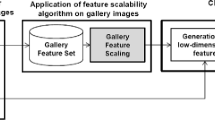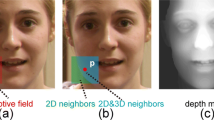Abstract
In this paper, a learning-based high-speed reconstruction system for ultra-low resolution faces is implemented using a software/hardware co-design paradigm. The hardware component working at 60 MHz contains a field programmable gate array, which is reconfigured to contain parallel processing units, and multiple memories to create parallel data. The hardware component effectively handles generating and sorting computationally intensive similarity metrics. This solves the processing speed problem in learning-based super-resolution reconstruction for ultra-low resolution faces. The system can reconstruct faces using 8×6, 16×12, and 32×24 sized images, with 4×4, 8×8, or 16×16 times magnification. The experimental results verify the effectiveness of our system in terms of both visual effect and low root mean square errors. The processing speed can be improved up to a maximum of 7900 times faster than a pure software implementation using C.
Similar content being viewed by others
References
Baker S, Kanade T. Limits on super-resolution and how to break them. Comput Vis Pattern Recogn, 2000, 9: 372–379
Baker S, Kanade T. Hallucinating faces. In: Proceedings of the 4th IEEE International Conference on Automatic Face and Gesture Recognition. America: IEEE Inc., 2000. 83–88
Liu C, Shum H Y, Zhang C S. A two-step approach to hallucinating faces: global parametric model and local nonparametric model. In: Proceedings of the 2001 IEEE Computer Society Conference on Computer Vision and Pattern Recognition Kauai Marriott. Piscataway: IEEE Press, 2001. 192–198
Wang X G. Hallucinating face by eigentransformation. IEEE Trans Syst Man Cy C, 2005, 35: 425–434
Su G D, Liu J X, Shang Y, et al. Theory and application of image neighborhood parallel processing. In: IEEE 16th International Conference on Image Processing (ICIP2009). Cairo: IEEE Publisher, 2009. 2313–2316
Su G D. New Neighborhood function pipeline structures in neighborhood image processor. Acta Electron Sin, 2000, 28: 1–4
Freeman W T, Jones T R, Pasztor E C. Example-based super-resolution. IEEE Comput Graph, 2002, 22: 56–65
Yang D Q, Su G D, Xu T W. A new technique for face image resolution enhancement based on face hallucination. In: Proceeding of the 27th Chinese Control Conference. Kunming: IEEE Publisher, 2008. 477–481
Chen B Y. The Development of a Large Neighborhood Image Processing System. Beijing: Tsinghua University, 2006. 1–50
Su G D. Image Parallel Processing Technology. Beijing: Tsinghua University Press, 2001. 65–70
Chen W F, Liu C H, Lander K. Comparison of human face matching behavior and computational image similarity measure. Sci China Ser F-Inf Sci, 2009, 52: 316–321
Author information
Authors and Affiliations
Corresponding author
Rights and permissions
About this article
Cite this article
Wang, L., Chen, J., He, J. et al. High-speed reconstruction for ultra-low resolution faces. Sci. China Inf. Sci. 55, 2102–2108 (2012). https://doi.org/10.1007/s11432-011-4457-7
Received:
Accepted:
Published:
Issue Date:
DOI: https://doi.org/10.1007/s11432-011-4457-7




